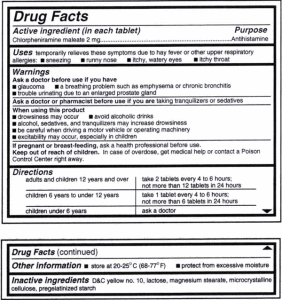Whether you are treating a headache or have a cold, it is important to read the label every time you take an over-the-counter (nonprescription) medication. The label will tell you what you need to know to safely take your medication and avoid a medication error or poisoning.
The FDA requires that the same information be listed in the same way on all nonprescription medications, from toothpaste to pain relievers, using the Drug Facts label. There is an example below. Note that dietary supplements are not required to use this label.
The Drug Facts label gives the following information:
- Active ingredient: The active ingredient is the ingredient in the product that has a medical effect. Some products have more than one active ingredient. This section shows:

Drug Facts label for chlorpheniramine, an antihistamine
Image courtesy of the FDA – Click to see a larger version- The name of the active ingredient
- How much of the ingredient is in each unit of measure. The unit might be 1 tablet, 30 milliliters of liquid, etc.
- Purpose: This section says what the product does and its drug category, such as antacid or pain reliever.
- Uses: This section lists the symptoms or medical condition the product is meant to prevent or treat.
- Warnings: Not every medication is right for every person. This section lists:
- Situations in which you should not take the medication
- Possible interactions with other medications or food
- When to stop taking the product
- When to call the doctor
- Safety information, such as to keep the medication out of the reach of children
- Directions: In many cases there is more than one set of directions, based on age or weight. The directions give instructions on:
- How to take the medication
- How much of the medication to take
- How often to take the medication
- How long to take it (for example, how many days)
- Inactive ingredients: This section lists substances that do not have a medical effect. They include substances that add flavor or color, or that hold the medication together (binding agents).
- Other information: This section often includes information on how to store the medication. It may have additional important notes not included in the other sections.




